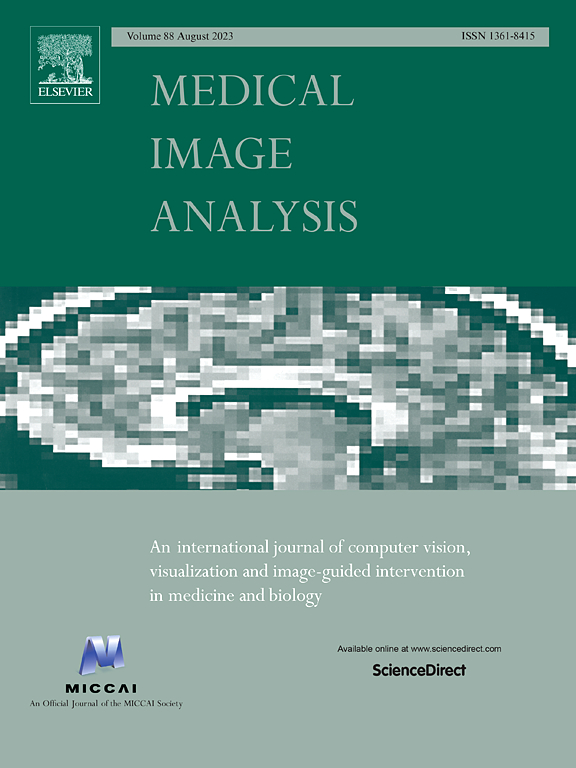IF 10.7
1区 医学
Q1 COMPUTER SCIENCE, ARTIFICIAL INTELLIGENCE
引用次数: 0
摘要
深度学习在自动脑肿瘤分割方面大有可为,但它依赖于昂贵的专家注释。无监督学习的最新进展提供了一种替代方法,即使用合成数据进行训练。然而,真实数据与合成数据之间的差异限制了无监督方法的准确性。在本文中,我们提出了一种通过两阶段图像合成策略在磁共振(MR)图像上进行无监督脑肿瘤分割的方法。这种方法考虑了真实数据与合成数据之间的领域差距,旨在生成真实的合成数据用于模型训练。在第一阶段,我们使用由手工制作的肿瘤形状和强度模型生成的合成脑肿瘤图像训练初级分割模型,并使用带有分布偏移的验证集进行模型选择。将训练好的初级模型应用于分割无标签的真实肿瘤图像,生成能捕捉真实肿瘤形状、强度和纹理的伪标签。在第二阶段,通过将大脑图像与肿瘤伪标签混合,生成逼真的合成肿瘤图像,从而缩小真实图像与合成图像之间的域差距。生成的合成数据随后用于训练高级模型,以进行最终分割。在五个脑成像数据集的实验中,被命名为 SynthTumour 的建议方法超越了现有的无监督方法,在脑肿瘤分割和缺血性中风病灶分割任务中都表现出了很高的性能。本文章由计算机程序翻译,如有差异,请以英文原文为准。

Unsupervised brain MRI tumour segmentation via two-stage image synthesis
Deep learning shows promise in automated brain tumour segmentation, but it depends on costly expert annotations. Recent advances in unsupervised learning offer an alternative by using synthetic data for training. However, the discrepancy between real and synthetic data limits the accuracy of the unsupervised approaches. In this paper, we propose an approach for unsupervised brain tumour segmentation on magnetic resonance (MR) images via a two-stage image synthesis strategy. This approach accounts for the domain gap between real and synthetic data and aims to generate realistic synthetic data for model training. In the first stage, we train a junior segmentation model using synthetic brain tumour images generated by hand-crafted tumour shape and intensity models, and employs a validation set with distribution shift for model selection. The trained junior model is applied to segment unlabelled real tumour images, generating pseudo labels that capture realistic tumour shape, intensity, and texture. In the second stage, realistic synthetic tumour images are generated by mixing brain images with tumour pseudo labels, closing the domain gap between real and synthetic images. The generated synthetic data is then used to train a senior model for final segmentation. In experiments on five brain imaging datasets, the proposed approach, named as SynthTumour, surpasses existing unsupervised methods and demonstrates high performance for both brain tumour segmentation and ischemic stroke lesion segmentation tasks.
求助全文
通过发布文献求助,成功后即可免费获取论文全文。
去求助
来源期刊

Medical image analysis
工程技术-工程:生物医学
CiteScore
22.10
自引率
6.40%
发文量
309
审稿时长
6.6 months
期刊介绍:
Medical Image Analysis serves as a platform for sharing new research findings in the realm of medical and biological image analysis, with a focus on applications of computer vision, virtual reality, and robotics to biomedical imaging challenges. The journal prioritizes the publication of high-quality, original papers contributing to the fundamental science of processing, analyzing, and utilizing medical and biological images. It welcomes approaches utilizing biomedical image datasets across all spatial scales, from molecular/cellular imaging to tissue/organ imaging.
 求助内容:
求助内容: 应助结果提醒方式:
应助结果提醒方式:


